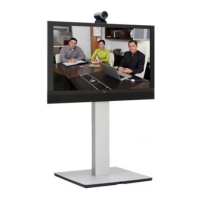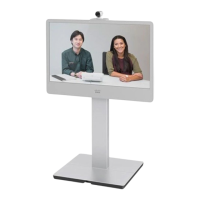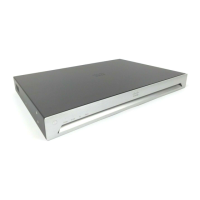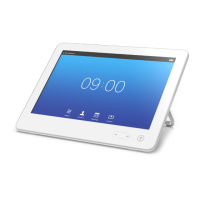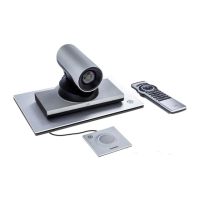D15119.02 MX700 and MX800 Administrator Guide TC7.2, AUGUST 2014. www.cisco.com — Copyright © 2014 Cisco Systems, Inc. All rights reserved.
111
Cisco TelePresence MX700 and MX800 Administrator Guide
Video Input Connector [1..5] OptimalDefinition Profile
This setting will only take effect if the corresponding Video Input Connector Quality setting is
set to Motion.
The optimal definition profile reflects the lighting conditions in the video conferencing room and
the quality of the camera. The better lighting conditions and the better quality of the camera,
the higher the profile. In good lighting conditions, the video encoder will provide better quality
(higher resolution or frame rate) for a given call rate. Generally, the Normal or Medium profiles
are recommended. However, when the lighting conditions are very good, the High profile can
be set in order to increase the resolution for a given call rate.
Some typical resolutions used for different optimal definition profiles, call rates and transmit
frame rates are shown in the table below. The resolution must be supported by both the calling
and called systems. Use the Video Input Source OptimalDefinition Threshold60fps setting to
decide when to use the 60 fps frame rate.
.
Requires user role: ADMIN
Value space: <Normal/Medium/High>
Normal: Use this profile for a normally to poorly lit environment. Resolutions will be set rather
conservative.
Medium: Requires good and stable lighting conditions and a good quality video input. For
some call rates this leads to higher resolution.
High: Requires nearly optimal video conferencing lighting conditions and a good quality video
input in order to achieve a good overall experience. Rather high resolutions will be used.
Example:
Video Input Connector 1 OptimalDefinition Profile: Medium
Video Input Connector [1..5] OptimalDefinition Threshold60fps
For each video input, this setting tells the system the lowest resolution where it should transmit
60fps. So for all resolutions lower than this, the maximum transmitted frame rate would be
30fps, while above this resolution 60fps would also be possible, if the available bandwidth is
adequate.
Requires user role: ADMIN
Value space: <512_288/768_448/1024_576/1280_720/1920_1080/Never>
512_288: Set the threshold to 512x288.
768_448: Set the threshold to 768x448.
1024_576: Set the threshold to 1024x576.
1280_720: Set the threshold to 1280x720.
1920_1080: Set the threshold to 1920x1080.
Never: Do not set a threshold for transmitting 60fps.
Example:
Video Input Connector 1 OptimalDefinition Threshold60fps: 1280 _ 720
Video Input Connector [1..4] PresentationSelection
Define how the video system will behave when you connect a presentation source to the video
input.
If the video system is in standby mode, it will wake up when you connect a presentation source.
Note that sharing the presentation with the far end always requires additional action (press
Share on the user interface).
Requires user role: ADMIN
Value space: Connector 1: <Manual> Connector 2: <Manual/Automatic/OnConnect> for
single camera systems, and <Manual> for dual camera systems Other connectors: <Manual/
Automatic/OnConnect>
Manual: In manual mode, the contents of the video input will not be presented on the screen
until you choose it from the user interface.
Automatic: In automatic mode, the contents on the video input will be presented on screen
automatically. If more than one source is set to Automatic, the last connected source will be
used. If any content is active (presented) when a call is disconnected, the content will still be
displayed locally.
OnConnect: When in on-connect mode, the content on the video input will be presented on
screen when a cable is connected. Otherwise, the behavior is the same as in manual mode.
Example:
Video Input Connector 1 PresentationSelection: Manual
Typical resolutions used for different optimal definition profiles, call rates and frame rates
Frame rate
Optimal
Definition
Profile
Call rate
768 kbps 1152 k b p s 1472 kbps 2560 kbps 4 Mbps
*
6 Mbps
*
H.265
(only in SIP calls)
30 fps
Normal 1280 × 720 1280 × 720 1280 × 720 1920 × 10 80 1920 × 1080 1920 × 1080
Medium 1280 × 720 1920 × 1080 1920 × 1080 1920 × 1080 1920 × 1080 1920 × 1080
High 1920 × 1080 1920 × 1080 1920 × 10 80 1920 × 1080 1920 × 108 0 1920 × 10 80
60 fps
Normal 768 × 448 1024 × 576 1280 × 720 1280 × 720 1280 × 720 1280 × 720
Medium 1024 × 576 1280 × 720 1280 × 720 1280 × 720 1280 × 720 1280 × 720
High 1280 × 720 1280 × 720 1280 × 720 1280 × 720 1280 × 720 1280 × 720
H.264
30 fps
Normal 1024 × 576 1280 × 720 1280 × 720 1920 × 1080 1920 × 1080 1920 × 1080
Medium 1280 × 720 1280 × 720 1280 × 720 1920 × 10 80 1920 × 1080 1920 × 1080
High 1280 × 720 1280 × 720 1920 × 1080 1920 × 108 0 1920 × 10 80 1920 × 10 80
60 fps
Normal 640 × 360 76 8 × 448 1024 × 576 1280 × 720 1280 × 720 1920 × 1080
Medium 768 × 448 1024 × 576 1024 × 576 1280 × 720 1920 × 1080 1920 × 1080
High 1024 × 576 1280 × 720 1280 × 720 1920 × 1080 1920 × 1080 1920 × 1080
*
H.265 is preferred over H.264, and the maximum bit rate for H.265 is 3 Mbps. When the user sets a higher
bit rate, the codec will still use H.265 at 3 Mbps as long as all codecs involved supports H.265.
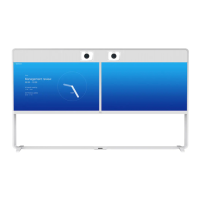
